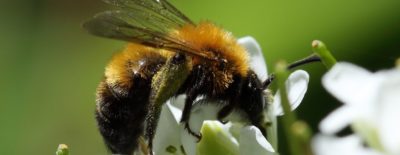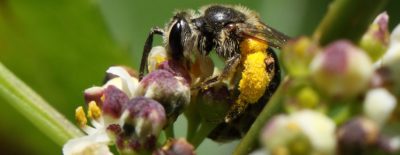This is a rough grouping, including species that are associated with the flowers of various woody shrubs; Dogwoods, Hawthorns, some Maples, Rhododendrons, Serviceberries, Spirea, Blueberries, and others. Most of these bees are active late May into June. Willow specialists are treated elsewhere.
Genus level ID: See the Mining Bee page for tips on separating other genera.
Click each box for more details on a given species.

Dogwood Mining Bees
A handful of Mining Bee species are closely associated with Dogwoods. As a group they are somewhat distinctive, though species-level identification from photos is challenging to impossible. Image courtesy Micheal Veit.

Blueberries
Two mining bees (and a handful of other bees) are specialists on blueberries. Both of the mining bees have noticeably long faces for reaching into the blueberry flowers.

Milwaukee Mining Bee (Andrena milwaukeensis)
This red-haired species is a generalist, but often found on Mountain Maple, Hawthorn, and other late spring shrubs. Image courtesy Micheal Veit.

Hawthorn Mining Bee (Andrena crataegi)
This is one of the most abundant late spring Mining Bees and can be found on a wide variety of shrubs and forbs, including Hawthorn.

Azalea Mining Bee (Andrena cornelli)
This rhododendron specialist is only known from a single site in Bennington County, but is worth looking for on Early Azalea (Rhododendron prinophyllum) in the southern parts of the state. Image courtesy USGS Bee Inventory and Monitoring Lab.

Short-tongued Miner Bee (Andrena brevipalpis)
While probably not a true specialist, this species has a strong affinity for Sumacs and Ceanothus, though the later is quite limited in Vermont

Cherry Mining Bee (Andrena pruni)
A number of species in the subgenus Melandrena can be found on flowering shrubs. This other species is one that can occasionally be identified from photos and has been found on cherries and serviceberries in the Champlain Valley. Image courtesy USGS Bee Inventory and Monitoring Lab.

Virginia Mining Bee (Andrena virginiana)
Vermont records for this late summer bee are few and far between. Seems to have a strong preference for Spirea and to be limited to the Champlain Valley. Image courtesy Micheal Veit.
Please note that many of our datasets have not been published yet, so the maps are incomplete.






